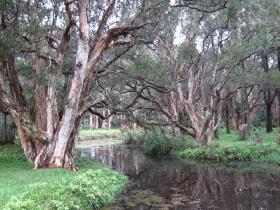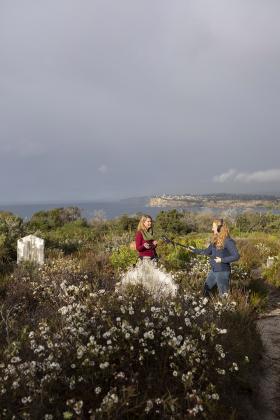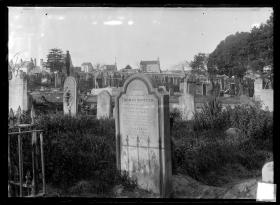For someone like me, who’s been curious about cemeteries since the very beginning of my life as a historian, this year’s History Week theme ‘From the Ground Up’ takes on a literal meaning. A stroll in a cemetery rewards the inquisitive researcher and can provide many leads for studying local and community history.
Cemeteries are not for the dead; they are for the living. Of course, their function is the disposal of the dead. But their meaning is created by the local community. Forget the main street with its town hall and post office, the cemetery is where I always start my local research. Until the 1960s, when cremation became the favoured disposal method, most people were buried in their local cemetery. It’s a microcosm of the town and documents many of the events and people that have shaped a locality.
The landscape and monuments of cemeteries were originally designed to encourage visitors. While some might baulk at the idea today, cemetery strolls were widely practised in the late nineteenth century. Our cemeteries should be ‘a place of festive or pensive resort as in many other countries’, the Sydney Morning Herald argued in 1862, since ‘an occasional stroll through the avenues of the well- kept cemetery will afford instruction without depression’. The 1879 Pfahlert’s Hotel Visitors’ Guide, or, How to Spend a Week in Sydney agreed, encouraging visitors to join the locals for a Sunday stroll in a cemetery.
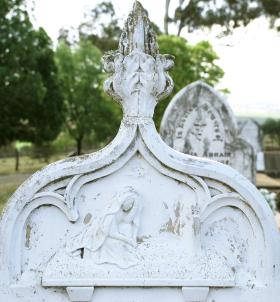
Today, the cemetery is where you’ll discover a town’s stories from the ground up: its highs and lows, its heroes and its villains. But the tales won’t be obvious at first. You need to take your time. Slow down, observe.
The location is the first clue. The site of a burial ground was chosen not only for ease of digging graves, but also in recognition of public health concerns, town demographics, and religious and cultural values. The location of the Glebe Cemetery at East Maitland, for example — one of the earliest in the Hunter district and the resting place of convict architect Francis Greenway — reminds us of surveyor TL Mitchell’s original plans for the town and the way its centre has shifted to West Maitland.
Australian churchyards reflect early religious affiliations and settlement patterns. Many in New South Wales and Tasmania are associated with the Church of England, while in South Australia a significant proportion catered for ‘dissenting’ religions, particularly Lutheran and Methodist. The general cemetery at Orange was originally a complex of separate denominational burial grounds with individual entrances. The divisions are still visible today in the gates, pathways and fence lines, although the cemetery is managed as one.
I practice ‘contemplative recreation’ whenever I visit a cemetery. I don’t dash for the big monuments — the obvious statements of influence, civic pride or money. I prefer to wander slowly among the tombstones, reading the inscriptions and looking at the symbolism.
Some historians have argued that most of the headstones and epitaphs in Australia were simply picked from a catalogue, with little imagination or individuality. While it’s true that catalogues were used, the observant cemetery visitor will notice many small variations that reflect personal choices and values.
There’s much to admire in the skilled carving of a sandstone headstone, and I look out for the names of stonemasons at the base: part artist’s signature, part advertisement. A cluster of talented sculptors and monumental masons in the Goulburn district — among them R Larcombe, TA Sealy, WJ Furber and J Turner — produced exuberant, ornately carved headstones for the Roman Catholic community. Their sculptures of seraphs, crockets (hook-shaped decorations), Celtic crosses, diving doves and the occasional mourning scene can be found as far afield as Collector, Boorowa and Canberra.
While many people prefer the look of nineteenth- century headstones, I’ve come to appreciate twentieth- century memorials. One of my favourites, at the cemetery outside Hill End, has used astro turf to create a golf fairway across the grave plot; the inscription reads ‘RIP on the 19th hole’.
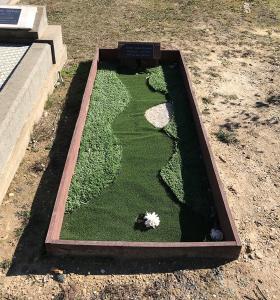
A community’s grief for a life cut short is often recorded on tombstone inscriptions. Accidental deaths testify to the perils of the sea, the challenges of life on the land, or the dangers of industrial work. The famous memorial to the wreck of the Dunbar at Camperdown Cemetery commemorates one of Sydney’s worst maritime disasters. Clusters of deaths in a particular month or year may indicate a wave of disease that swept through a town, and miniature grave plots are a stark reminder of the high rate of infant mortality endured by families and communities well into the twentieth century.
Tragedy and distress are everywhere. A marble headstone in the St John’s Anglican churchyard at Booral, now sadly broken in two, records the deaths of Alan and Mary McAskell, who were murdered at the local wharf on 30 January 1878. While this violent case that shook the community was never solved, the epitaph promises that justice will one day come for the righteous: ‘Vengeance is mine; I will repay, saith the Lord’.
Less dramatic events can be deduced from similarities and differences in neighbouring headstones. The shapes and lettering styles reflect trends in design but, as every genealogist will tell you, they can also help demonstrate family origins and relationships or, through an absence, point to a family rift.
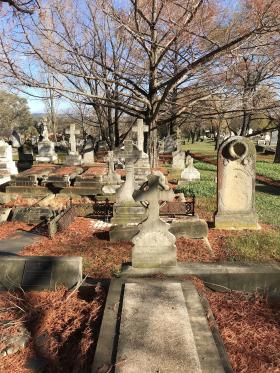
When visiting a graveyard we should always ask ourselves who is being represented and who is missing. Those who are marginalised or outcast through race, poverty or social stigma are often shunted to the side in unmarked graves, or even banished from the cemetery. The Aboriginal bushranger Joe Governor was buried outside the Anglican Cemetery at Whittingham, near Singleton. It was only years later that a plaque was placed where his unmarked grave is believed to be.
So, what are you waiting for? On your next lockdown stroll, why not head to your local cemetery? You might be surprised at what you discover from the ground up.
Dr Lisa Murray is the City of Sydney Historian and the author of Sydney Cemeteries: A Field Guide. She is the Library’s 2021 Hertzberg Fellow.
This story appears in Openbook Spring 2021.


